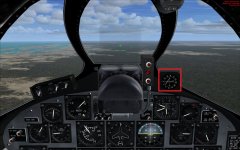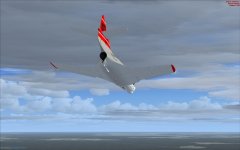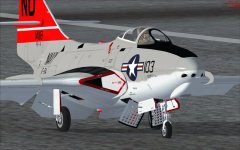Mike71
SOH-CM-2025
For those interested in tech mods to the aircraft.cfg file, my old notes show this
Fuel system: this was fully automatic with the exception of selecting drop tank transfer to the main cell. Their were two fuselage bladders interconnected, but so what. These were the quantities for the -8, as could be changed in your cfg file:
Center1 = -0.0, 0.0, -1.50, 830.5, 16.5
LeftMain = -4.1, -7.9, -0.8, 107.5, 0.5
RightMain = -4.1, 7.9, -0.8, 107.5, 0.5
J-48-P8 engine with 7250 lb thrust
NATOPS data for weights:
Empty Weight (including a 210 lb pilot with flight gear): 12400 lb typical
Max Field Takeoff: 25,000 lb
max Catapult Launch: 24,500 lbs
Max Field Landing: 17,000 lbs
Max Arrestment; 16,000 lbs
High OAT takeoff info - SEA LEVEL (flaps DOWN): takeoff INADVISABLE
OAT (F) TOW Limit (lb) Vr / Climbout (KIAS) Ground Run - Zero Wind (ft)
100 22,000 135 7150
90 23,400 139 7500
60 25,000 145 6700
Airspeed limits: Gear/Flaps/ Canopy open - 220 KIAS
Speed Brakes - 0.95 IMN
No max KIAS or max IMN - limited by airframe drag. However, an extensive g vs speed envelope had to be complied with ("V-n Diagram").With drops or ordnance, I assume at that time it was 450 KIAS / 0.90 IMN, but need to dig further.
I recall gear and flaps being revised to 250 KIAS, but not sure.
I reported to NAS Kingsville for advanced jet training in August of 1965, got my wings in November. God, South Texas can get hot!
I never flew with the canopy open. When Martin-Baker developed the 100 knot seat with automatic seat-man separation, this was no longer done.
I never flew the single or two-seater with external tanks or ordnance except with 25 lb "turd bombs" used for practice. Our single seaters had the two inboard nose cannons removed to reduce weight and maintenance costs.
We typically climbed at 300 KIAS to 0.72 IMN to about FL300 for cruise at 0.72 best range. I will get some better data later. As I recall, we started to comply with what I believe were fairly new rules about 250 KIAS below 10,000 MSL when not in a military practice area.
Remember, this was a centrifugal flow engine with a chubby profile; high thrust to weight and aerodynamic elegance were lacking.
By the time I was flying the Cougar, Navy jets had the AoA system and we used it like religion. It consisted of both a round gauge/ needle and the indexer chevron lite "V donut inverted V", all colored yellow. Today I believe they are red for slow, yellow donut and green fast chevron. They were mounted on the upper left, the gauge under the glare shield, the indexer lights on the glare shield. This is pretty standard on any jet as far as I know.
I never saw a Navy tactical airplane with ILS - we used PAR radar, and in my opinion is better than ILS if the controller is good, which they always seemed to be. We only had TACAN, which is UHF bearing and DME, coupled together and channelized. We used UHF comms, and had UHF ADF, not LF ADF. I believe P-3s had ILS, and the transports did. First ILS I ever used in a Navy plane was when I did the acceptance tests on the C-12B KingAir 200. I had a lot of civilian flight experience as well, so I got that bonus assignment at Pax River. What a good deal.
The Cougar had no autopilot -this was typical in those days. The Navy was worried about pilots in a single-seater dozing off and running low on fuel, and tactical jets in the air for more than a couple of hours was unusual.
Fuel system: this was fully automatic with the exception of selecting drop tank transfer to the main cell. Their were two fuselage bladders interconnected, but so what. These were the quantities for the -8, as could be changed in your cfg file:
Center1 = -0.0, 0.0, -1.50, 830.5, 16.5
LeftMain = -4.1, -7.9, -0.8, 107.5, 0.5
RightMain = -4.1, 7.9, -0.8, 107.5, 0.5
J-48-P8 engine with 7250 lb thrust
NATOPS data for weights:
Empty Weight (including a 210 lb pilot with flight gear): 12400 lb typical
Max Field Takeoff: 25,000 lb
max Catapult Launch: 24,500 lbs
Max Field Landing: 17,000 lbs
Max Arrestment; 16,000 lbs
High OAT takeoff info - SEA LEVEL (flaps DOWN): takeoff INADVISABLE
OAT (F) TOW Limit (lb) Vr / Climbout (KIAS) Ground Run - Zero Wind (ft)
100 22,000 135 7150
90 23,400 139 7500
60 25,000 145 6700
Airspeed limits: Gear/Flaps/ Canopy open - 220 KIAS
Speed Brakes - 0.95 IMN
No max KIAS or max IMN - limited by airframe drag. However, an extensive g vs speed envelope had to be complied with ("V-n Diagram").With drops or ordnance, I assume at that time it was 450 KIAS / 0.90 IMN, but need to dig further.
I recall gear and flaps being revised to 250 KIAS, but not sure.
I reported to NAS Kingsville for advanced jet training in August of 1965, got my wings in November. God, South Texas can get hot!
I never flew with the canopy open. When Martin-Baker developed the 100 knot seat with automatic seat-man separation, this was no longer done.
I never flew the single or two-seater with external tanks or ordnance except with 25 lb "turd bombs" used for practice. Our single seaters had the two inboard nose cannons removed to reduce weight and maintenance costs.
We typically climbed at 300 KIAS to 0.72 IMN to about FL300 for cruise at 0.72 best range. I will get some better data later. As I recall, we started to comply with what I believe were fairly new rules about 250 KIAS below 10,000 MSL when not in a military practice area.
Remember, this was a centrifugal flow engine with a chubby profile; high thrust to weight and aerodynamic elegance were lacking.
By the time I was flying the Cougar, Navy jets had the AoA system and we used it like religion. It consisted of both a round gauge/ needle and the indexer chevron lite "V donut inverted V", all colored yellow. Today I believe they are red for slow, yellow donut and green fast chevron. They were mounted on the upper left, the gauge under the glare shield, the indexer lights on the glare shield. This is pretty standard on any jet as far as I know.
I never saw a Navy tactical airplane with ILS - we used PAR radar, and in my opinion is better than ILS if the controller is good, which they always seemed to be. We only had TACAN, which is UHF bearing and DME, coupled together and channelized. We used UHF comms, and had UHF ADF, not LF ADF. I believe P-3s had ILS, and the transports did. First ILS I ever used in a Navy plane was when I did the acceptance tests on the C-12B KingAir 200. I had a lot of civilian flight experience as well, so I got that bonus assignment at Pax River. What a good deal.
The Cougar had no autopilot -this was typical in those days. The Navy was worried about pilots in a single-seater dozing off and running low on fuel, and tactical jets in the air for more than a couple of hours was unusual.
Last edited:






